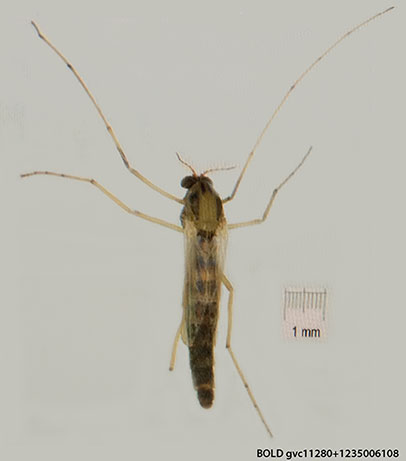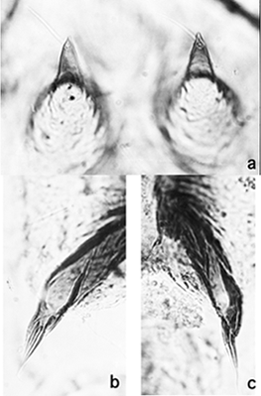C. circumdatus Kieffer 1916.Synonym: C. basitibialis Tokunaga 1936
C. bharati Singh & Kulshretha 1976 (doubtful synonymy Ð see description of C. bharati)
C. costatus sensu Karunakaran 1969 (mtCOI - Wong, unpubl.; cytology - Martin unpubl.)
C. plumatisetigerus Tokunaga, 1945 (Martin and Saxena 2009)
C. setonis Tokunaga 1936 (Yamamoto 2013)
Probable Syn: C. costatus Johannsen 1932 (see C. costatus)This species is a member of the "C. flaviplumus-group". In BOLD Bin: BOLD:AAG5483Adult
Male:

Male terminalia of C. circumdatus.
Anal point relatively narrow, superior volsella curved at the tip.Head: AR about 3.5. Frontal tubercles about 25-43 micron long, 10-17 micron wide. Palpal proportions (micron) 56 : 54 : 213 : 218 : 334. Clypeal setae - 17-34.
Thorax greenish, scutal stripes conspicuous with dark brown margins; scutellum pale yellow, postnotum dark brown.
Thoracic setae: acrostichals - 12-18; dorsocentrals - 18-27; prealar - 5-6; scutellar - 8-14 in anterior row, 13-26 in posterior row (higher numbers have an intermediate row of 11-12 setae).
Wing length: 2.80 mm; wing width 0.67 mm; VR about 1.02-1.05. Wings without darkening of the crossvein. 25-27 setae on anal fringe.
Legs pale, with darkening at distal ends, also on distal half of Ti4 and all of Ta5.
Leg lengths (microns) and proportions as follows:
| Fe
| Ti
| Ta1
| Ta2
| Ta3
| Ta4
| Ta5
| LR
| F/T
| BR
| PI
| 1165
| 1058
| 1590
| 865
| 765
| 660
| 335
| 1.40-1.67
| 1.04-1.18
| 1.6-2.4
| PII
| 1230
| 1110
| 705
| 395
| 295
| 165
| 135
| 0.62-0.66
| 1.05-1.13
|
| PIII
| 1350
| 1350
| 1000
| 560
| 475
| 250
| 170
| 0.72-0.81
| 0.97-1.02
|
| Abdominal segments pale, but with increasing central dark oval patch, so that tergites V-VIII are vrtually all dark.
Anal point narrow at base, with 5-13 setae in individual pale spots on tergite IX. Superior volsella closest to D(e)-type of Strenzke (1959), but tip may be more bent. Sasa classes Japanese material as E-type, although one illustration looks more like a D-type. Setae on inferior volsella forked.Female (based on Sasa 1978 and Australian specimens):
Wing length 2.73-2.8 mm., width 0.82, VR 0.93; 2 SCf on brachiolum, at least 21 setae on squamal fringe.
Head: Frontal tubules 38 µm long, 11 µm wide (3.3 times longer than wide).
Antennal proportions (approx. % of neck in brackets) (micron): 138 (28) : 103 (37) : 114 (40) : 113 (45) : 164. AR 0.27. A5/A1 1.21.
Palpal proportions (µm): 89 : 56 : 205 : 230 : 540; P5/P4 1.69-2.34; P5/P3 2.14-2.34.
Thoracic setae: Acrostichal Ð 16; Dorsocentrals + humerals - 21, 24; Prealar - 5, 5; Supraalar 1, 1; Scutellars in 2 rows, anterior - 7 setae, posterior with 14 larger setae (total 21 setae).
Adult female of C. circumdatus from Australia. (from BOLD)

Leg lengths (microns) and proportions as follows:
| Fe
| Ti
| Ta1
| Ta2
| Ta3
| PI
| 1440
| 1150
| 2050
| 1000
| 930
| PII
| 1630
| 1340
| 810
| 410
| 290
| PIII
| 1490
| 1490
| 11500
| 560
| 460
|
| Ta4
| Ta5
| LR
| F/T
| Ta4/Ti
| PI
| 880
| 410
| 1.79
| 1.25
| 0.43
| PII
| 180
| 150
| 0.60
| 1.22
| 0.13
| PIII
| 270
| 180
| 0.77
| 1.00
| 0.18
| Abdominal tergites almost entirely dark brown, with narrow apical pale bands on tergites I to VII.

Pupa:
Brown. Exuviae pale brown.
Body about 6.6-7.7 mm (male) and 6.5-7.6 mm (female).
Frontal tubercles (Fig. a) about 70-100 µm, with a subapical seta (40-80 µm).
Thorax rugose, with 2 pairs of precorneal setae.
Abdominal tergite II with median shagreen and about 52-68 hooklets, tergites
III-V entirely with shagreen, tergite VI with T-shaped shagreen, tergites VII-VIII
with 2 broad patches of shagreen.
Caudolateral spur (Figs. b & c) with about 2-4 spines.Fourth instar larva:
a medium plumosus-type (length 8.7-14.3 mm; females 12.9 (11.0-14.3) mm; males 11.8 (11.0-12.5) mm), lateral tubules well developed (about 350 (220-480) µm).
Posterior pair of ventral tubules (2.30 (1.52-2.76) mm) generally longer than anterior pair (1.84 (1.36-2.48 mm; post. 1.52-2.76 mm), and coiled. Anal tubules may vary in size in different areas, from about 2x longer than wide (Allahabad), to 3-4x longer in other areas; length 290-440 µm, width 80-165 µm. Clypeal aperture about 63 µm long and 3.9 times longer than wide.
Gular region darkened on posterior third to half, frontoclypeus variable from very slightly darkened to dark.
Mentum (Fig. c.) with fourth laterals reduced to about the level of the 5th laterals (type II), 6th laterals pointed outwards; c2 teeth of the central tooth mentum well separated (type III).
Ventromentum (d, below) about 215 µm wide and 3.8 times wider than deep, about 1.14 times the mentum width, with about 38 (30-42) striae.
Pecten epipharyngis (Fig. a) with about 11.5 (10-14) teeth, often more worn than pictured.
Premandible with inner tooth about 2-3.5 times the width of the outer, coming to a fine point (type B1).
Antenna (Fig. b) with basal segment 2.8-3.5 times as long as wide, RO about a quarter to halfway up from the base; A2/A1 about 0.24-0.31; A5/A3 about 0.67-1.6; AR about 2.42 (2.21-2.67); relative segment lengths (micron) 112 : 25 : 6 : 10.5 : 6.5.
Distance between antennal bases greater than that between the S4 setae, which are separated by about 0.8 of the frontoclypeal width.
Mandible (Fig. e) with third inner tooth mostly slightly darkened and only partly separated (type IA-IIB), about 11-14 furrows on outer surface near the base; 8-10 taeniae in PMa; Mdt-Mat/Mand len. abt 0.11-0.12.
Anal tubules may vary in size in different areas, from about twice as long as wide (Allahabad) to more than three times as long as wide (Jammu & Singapore), length 290-440 µm, width 80-165 µm., with a medial constriction. Salivary reservoir about 46-63 µm long and 2.6-3.9 times longer than wide. Cytology. Found: India to Thailand, to New Guinea, Australia and the Pacific area.
Type locality: Tainan (abt 23.0°N, 120.0°E), Yentempo, (formerly Takao Prefecture), FORMOSA (TAIWAN).
India - Yamuna River near Interstate Bus Terminals, East Delhi; Okhla, South East Delhi; University of Jammu & Kashmir, Jammu.
(32.73°N, 74.87°E), Bishnah wetland 32.70°N, 75.00°E), Suchetgarh, Jammu & Kashmir; Madurai, Tamil Nadu (9.91°N, 78.00°E);
Varanasi, Banaras, Uttar Pradesh (25.20°N, 83.03°E)
Indonesia - Kampung Damai, Balikpapan (-1.25°S, 116.82°E), Kalimantan.
Malaysia - Langat River, Selangor.
Singapore - Sungei Api Api (1.37°N, 103.94°E).
Thailand: - Ban Bangkanark, Chachoengsao Province (Hashimoto et al. 1981); Bangkok area; Ban Don Chi, Amphoe Phibun
Mangsahan, Ubol Ratchathani Province (Hashimoto et al. 1981); Ban Haet, Ban Phai, Borabue, Changhan, Chiang Khwan, Chiang yuen,
Kamalasai, Kantharavichai, Kham Ta Kla, Meuang Kalasin, Meuang Khon Kean, Meuang Nakhon Phanom, Meuang Roi Et,
Na Kae, Phang Khon, Pra Yuen, Renu Nakhon, Rong kham, Sawang Daen Din, Si Somdet, That Phanom, Yang Talat, Wanon Niwat
(mostly from Pramual et al. 2008). The morphology was redescribed by Sasa (1978) and Chaudhuri et al. (1992).
Chromosomes described by Kumar & Gupta (1990) and Pramual et al. (2008) as C. circumdatus, by Kuvangkadilok (1985) from Thailand, and for arms A, E and F (with some errors) by Saxena (1995) as C. plumatisetigerus.
This species can be bred in the laboratory (Kuvangkadilok 1994). DNA Sequence
mtCOI: sequence is in GenBank for Malaysia (acc.no. JQ287751), Thailand (acc.nos. KT212956-977, JQ287747-51), Singapore (acc.no. KJ530968). See also C. flaviplumus, C. claggi, C. "orientalis", C. indiaensis, C. nr. flaviplumus.[ Return to Index| Go to References ] |


